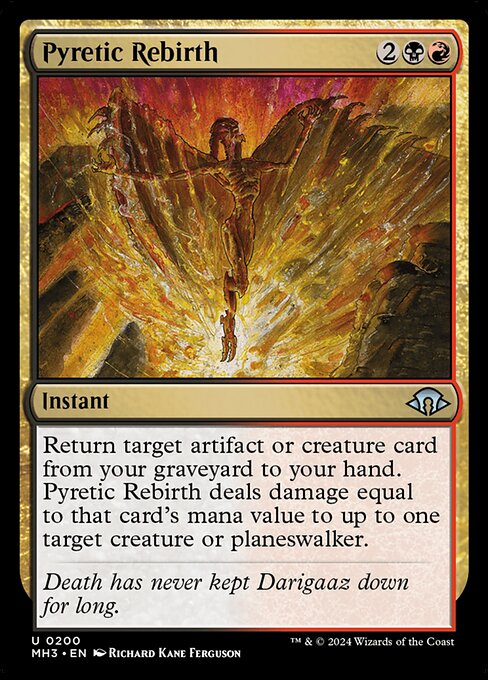
Image courtesy of Scryfall.com
Threat assessment around Pyretic Rebirth
In the colorful, chaos-laden space of Modern Horizons 3, Pyretic Rebirth stands out as a compact two-for-one that rewards patient graveyard work while delivering a surprise punch. This 4-mana instant, colored in both black and red mana, offers two distinct rails of value: you can reclaim resources from your graveyard and you can burn the board in the same stroke. It’s the kind of card that tempts you to build a deck around it, and that tension is exactly what makes threat assessment so interesting 🧙♂️🔥.
“Death has never kept Darigaaz down for long.”
What the card does, in practical terms
The spell reads: “Return target artifact or creature card from your graveyard to your hand. Pyretic Rebirth deals damage equal to that card's mana value to up to one target creature or planeswalker.” Two lines, one moment, big decisions. Here are the knobs you’ll typically turn in games:
- Graveyard value: The returned card goes to your hand, not the battlefield. That means you get to recast or reuse a threat or a mana rock, which can be a powerful tempo play in the right setup.
- Potential damage scale: The dmg equals the mana value (mana cost) of the returned card. That means a small fetch yields modest ping, while grabbing a high-value artifact or creature can deliver a decisive burn to a single target—often a planeswalker or a sturdy creature 🧨.
- Color identity and flexibility: As a RB spell, it slots neatly into Rakdos-colored shells that love midrange interaction, aggressive disruption, and a dash of reckless flame. The instant speed also lets you respond to threats or push damage in clutch moments ⚔️.
Threat dynamics by format
Every card shines differently depending on the venue. Here’s how Pyretic Rebirth tends to behave in popular MTG ecosystems:
- Modern & Historic: It’s a solid piece in graveyard-centric shells and artifact-heavy strategies. The threat isn’t relentless card advantage on a single card; it’s two-for-one value that can fuel a late-game swing. The requirement that the returned card be in your own graveyard keeps you honest against graveyard hate that targets your graveyard directly, but you’ll still want support cards to fill and protect your graveyard. The potential for big damage with a high-mana-value return can threaten finish lines when combined with removal-heavy sequences 🧙♂️💥.
- Commander/EDH: In a multi-player setting, Pyretic Rebirth can enable some delightful commander turnarounds. Returning a key artifact or a big creature to hand and then deploying it again can create a surprising tempo swing. Flavor-wise, it echoes the lore of resilience—Darigaaz’s flame rekindled in a new form—and mechanically, it rewards a graveyard that’s already humming. It’s not a slam-dunk include in every Rakdos deck, but in Aristocrat- or Reanimator-adjacent commanders, it’s a potent value engine that can disrupt opponents’ boards while you rebuild yours 🔥🎲.
- Draft: As a modern horizon-influenced card, it’s a bit more niche in Limited. You’ll want a deck that can reliably fuel the graveyard and that can leverage the hand recycle to impact the board on the same turn or next. In draft, consistency can be the bottleneck, but when you untap with a big artifact or creature in grave, the pays-off can be dramatic ✨.
Strategic takeaways for threat-aware players
- Target choice matters: The mana value of the returned card sets the table for your follow-up. If your graveyard is full of affordable threats and value artifacts, Pyretic Rebirth becomes a steady engine. If you’ve got a rare, high-value artifact like a power-combat artifact, the potential burn can be game-ending—but only if you can resolve the spell and manage your mana while keeping pressure on the opponent.
- Graveyard setup matters: You’ll want natural ways to fill your graveyard and protect it. Spells like cantrips, or graveyard enablers that don’t overstep your game plan, ensure Pyretic Rebirth often meets its full potential rather than fizzling when the graveyard is empty.
- Counterplay and hate: Opponents may answer with graveyard hate or instant-speed removal. Because Pyretic Rebirth targets your graveyard, it’s important to balance threats that keep your yard active with ways to protect the key pieces you’re hoping to return to hand.
- Budget-friendly edge: In many tables, the card’s price range remains accessible, making it a value pick for budget builds. The card’s rarity and price hints at a niche utility rather than a surefire meta-breaking staple, but that’s often exactly what makes it a darling of control and midrange communities 🧠💎.
Deck-building notes and aesthetics
Pyretic Rebirth nods to the dual nature of its namesake—rebirth through fire and shadow. Its flavor text anchors a dragon-tinged world where life cycles return after ruin, and the art by Richard Kane Ferguson makes that mood tangible. For designers and players who love a thematic fit, this card is a textbook example of how a single spell can deliver both inevitability and surprise, a microcosm of MTG’s design philosophy 🎨⚔️.
From a practical standpoint, consider pairing it with a handful of support cards that help you fill and protect your graveyard (think cantrips and reanimation helpers) and spell a few finishers that capitalize on big mana values. The combination of hand advantage and immediate damage is deceptively potent when it lands in the right moment 🧙♂️💥.
Gaming Rectangular Mouse Pad Ultra-Thin 1.58mm Rubber BaseMore from our network
- https://blog.rusty-articles.xyz/blog/post/magic-the-gathering-bitter-revelation-artist-commentary-and-production-techniques/
- https://transparent-paper.shop/blog/post/how-user-reviews-impact-seo-signals-clicks-and-conversions/
- https://crypto-acolytes.xyz/blog/post/web3-identity-fraud-prevention-practical-strategies/
- https://transparent-paper.shop/blog/post/brightness-maps-a-30792-k-blue-giant-class/
- https://blog.digital-vault.xyz/blog/post/breaking-the-fourth-wall-in-mtg-design-with-sparkmage-apprentice/